With the announcement of vSphere 6 one of the touted features was improved integration between Site Recovery Manager 6 and vSphere 6’s Storage DRS feature when using array based replication. Since SRM 5.5 and vSphere 5.5 the two capabilities have been supported together with some caveats. With the newly announced release the integration between the two will be much simpler. This post will focus on array based replication but as noted in Cormac’s post the SDRS and vSphere Replication integration has also improved.
Okay, Tell Me More About Those Array Based Replication Caveats
Since SRM 5.5 you have been able to use Storage vMotion to move protected VMs between datastores belonging to the same consistency group. However there was nothing to warn users when they were migrating a VM outside of the consistency group (or even onto non-replicated datastores) or prevent Storage DRS doing the same.
To workaround this there are two key items customers have been doing:
- Monitor Alarms: First, for storage vMotion you should ensure you are monitoring the appropriate SRM alarms to be informed if an administrator inadvertently migrates the storage of a VM (e.g. the SPVmLostEvent is a good one to alert on in this instance). Eric Shank’s SRM 5.8 guide provides a good overview of how to configure SRM 5.8 alarms.
- One Consistency Group Per Cluster: Additionally, prior to vSphere 6.0, Storage DRS was not aware of array based replication so could migrate a protected VM onto a non-replicated datastore or onto a datastore belonging to a different consistency group within the cluster. To avoid this you would have to set up your datastore cluster to only contain datastores belonging to the same consistency group.
So What Changes in vSphere 6 and SRM 6?
The SRM and Storage DRS teams have worked together to make SDRS aware of which datastores are being replicated and the consistency group membership. When SRM discovers replicated devices it associates information to the appropriate datastores in vSphere (e.g. that it is replicated and the consistency group), this information is then used by SDRS in deciding which automatic moves it can make, SDRS will not perform any automatic migrations that would impair the recoverability of a VM with SRM.
With this change you don’t have to be as fine-grained with your storage clusters, or alternatively as coarse in your failover granularity. Now you can mix non-replicated and replicated datastores in the same cluster, and even replicated datastores belonging to different consistency groups.
This reduces the operational burden of working with SRM and SDRS and provides much more flexibility in how you choose to organize your datastores and datastore clusters.
[Update March 17th 2015] – There is now a KB article, How Site Recovery Manager Handles Storage DRS Tagging (2108196), that goes into some more detail on how SRM and SDRS interoperate using tags.
